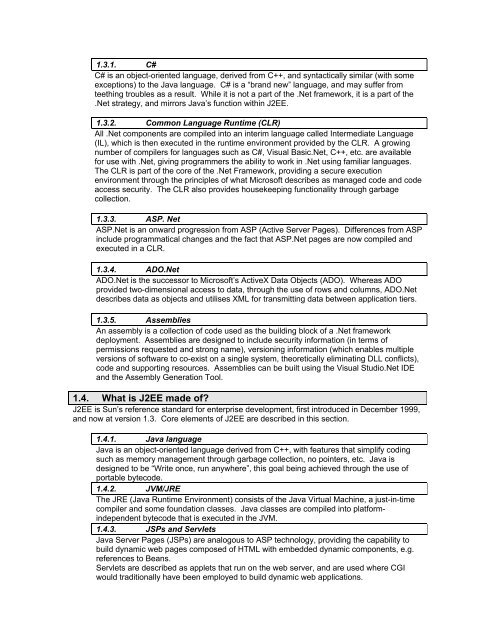J2ee and .Net security, (PDF) - CGISecurity
J2ee and .Net security, (PDF) - CGISecurity
J2ee and .Net security, (PDF) - CGISecurity
Create successful ePaper yourself
Turn your PDF publications into a flip-book with our unique Google optimized e-Paper software.
1.3.1. C#<br />
C# is an object-oriented language, derived from C++, <strong>and</strong> syntactically similar (with some<br />
exceptions) to the Java language. C# is a “br<strong>and</strong> new” language, <strong>and</strong> may suffer from<br />
teething troubles as a result. While it is not a part of the .<strong>Net</strong> framework, it is a part of the<br />
.<strong>Net</strong> strategy, <strong>and</strong> mirrors Java’s function within J2EE.<br />
1.3.2. Common Language Runtime (CLR)<br />
All .<strong>Net</strong> components are compiled into an interim language called Intermediate Language<br />
(IL), which is then executed in the runtime environment provided by the CLR. A growing<br />
number of compilers for languages such as C#, Visual Basic.<strong>Net</strong>, C++, etc. are available<br />
for use with .<strong>Net</strong>, giving programmers the ability to work in .<strong>Net</strong> using familiar languages.<br />
The CLR is part of the core of the .<strong>Net</strong> Framework, providing a secure execution<br />
environment through the principles of what Microsoft describes as managed code <strong>and</strong> code<br />
access <strong>security</strong>. The CLR also provides housekeeping functionality through garbage<br />
collection.<br />
1.3.3. ASP. <strong>Net</strong><br />
ASP.<strong>Net</strong> is an onward progression from ASP (Active Server Pages). Differences from ASP<br />
include programmatical changes <strong>and</strong> the fact that ASP.<strong>Net</strong> pages are now compiled <strong>and</strong><br />
executed in a CLR.<br />
1.3.4. ADO.<strong>Net</strong><br />
ADO.<strong>Net</strong> is the successor to Microsoft’s ActiveX Data Objects (ADO). Whereas ADO<br />
provided two-dimensional access to data, through the use of rows <strong>and</strong> columns, ADO.<strong>Net</strong><br />
describes data as objects <strong>and</strong> utilises XML for transmitting data between application tiers.<br />
1.3.5. Assemblies<br />
An assembly is a collection of code used as the building block of a .<strong>Net</strong> framework<br />
deployment. Assemblies are designed to include <strong>security</strong> information (in terms of<br />
permissions requested <strong>and</strong> strong name), versioning information (which enables multiple<br />
versions of software to co-exist on a single system, theoretically eliminating DLL conflicts),<br />
code <strong>and</strong> supporting resources. Assemblies can be built using the Visual Studio.<strong>Net</strong> IDE<br />
<strong>and</strong> the Assembly Generation Tool.<br />
1.4. What is J2EE made of?<br />
J2EE is Sun’s reference st<strong>and</strong>ard for enterprise development, first introduced in December 1999,<br />
<strong>and</strong> now at version 1.3. Core elements of J2EE are described in this section.<br />
1.4.1. Java language<br />
Java is an object-oriented language derived from C++, with features that simplify coding<br />
such as memory management through garbage collection, no pointers, etc. Java is<br />
designed to be “Write once, run anywhere”, this goal being achieved through the use of<br />
portable bytecode.<br />
1.4.2. JVM/JRE<br />
The JRE (Java Runtime Environment) consists of the Java Virtual Machine, a just-in-time<br />
compiler <strong>and</strong> some foundation classes. Java classes are compiled into platformindependent<br />
bytecode that is executed in the JVM.<br />
1.4.3. JSPs <strong>and</strong> Servlets<br />
Java Server Pages (JSPs) are analogous to ASP technology, providing the capability to<br />
build dynamic web pages composed of HTML with embedded dynamic components, e.g.<br />
references to Beans.<br />
Servlets are described as applets that run on the web server, <strong>and</strong> are used where CGI<br />
would traditionally have been employed to build dynamic web applications.










